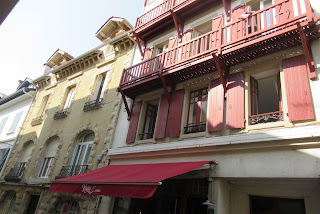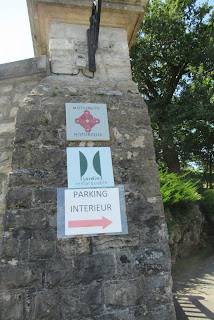Séjour au Pays Basque
 |
| Coastline: St. Jean de Luz |
DAY 1: I stayed just outside of town, actually just about right on the beach, at Villa Argi Eder. Owners Véronique and Pascale are a delightful couple. Only drawback was that they had a lot of family visiting, which included two NOISY little girls, with parents, grandparents and great grandmother all interacting with them, which made it a bit less than restful at times. However, also had some great conversations, and made me want to run a B&B again!
 |
| This town -- in fact, this whole area -- is Europe's surfing mecca. |
The town of St. Jean de Luz itself is charming, or it would be if not for the throng of tourists!
However, the typical Basque architecture is delightful (notice in photos below how I sought out the more quiet spots!); the town's own shoreline, port and beaches are lovely; and historically it's known for its church, where France's "Sun King", Louis XIV, married Maria Thérèsa in 1660:
...into the beach resort and surfing hotspot of Hendaye:
And then across the border into Spain (ha, hah -- I'd taken my passport but saw no border sign nor any border "authorities") into the gorgeous city of San Sebastian...
 |
| I took this picture for two reasons: the backs of the heads of the seated, elderly couple, and the texture of the trees! |
Basque country is unique -- it has its own culture (see traditional dress below)...
...its own language, which is virtually unintelligible to anyone else, and thus makes sign-reading quite challenging...
...and most of all, its cuisine (land of pimentos and huge variety of fish)-- and San Sebastian is the capital of Spanish cuisine with more Michelin stars than anywhere else in the country.
Now I am not a "foodie", but even I can appreciate the incredible, delicious "pintxos", the small portions of various dishes, often stacked on pieces of bread. What an array of "open-faced sandwiches" from which to choose for lunch, from a huge selection of restaurants in the old town!
Now I had to decide: head back to France, or continue south in Basque Country Spain for a little more than an hour, to hit a bucket list item: the Guggenheim Museum in Bilbao, the architectural icon designed by Frank Gehry? Ah....no contest.... ;)
...and then the drive back through the Pyrenees, to St Jean... I did the whole drive myself, no maps, no GPS -- just great roads and great signage! :)
DAY 3: Today I was going to explore more of the interior of French Basque country -- some of the small towns. Out of St. Jean, first stop was Ascain, where I bought a long, white traditional Basque white linen dress/robe at the "brocante" pictured (but it wasn't second-hand, so more of a "boutique" than a "brocante"):
I went through Col de Saint Ignac and right past its tourist train to La Rhune (in the mountains) as fast as I could because SO crowded with tourists, stopping along the curving, mountain route for some views that appealed to me:
...and then into the town of Sare...
I was captivated by the cemetery (as I often am), its workers, and its adjacent church.
 |
| There was a family also looking at the tombstones, and the woman was saying she'd never seen a decoration like this one, with the beading and flowers behind glass: |
 |
| Church interior |
Final stop - "Arnaga", the estate in Cambo les-Bains of Edmond Rostand, poet/writer/playwright, who wrote "Cyrano de Bergerac" and "Chanticleer" (hence the big bird costumes!)
 |
| The formal French gardens in the front of the property... |
 |
| ...and the less formal, "English" gardens in the back. |
 |
| Rostand was, above all, a man of the theatre -- and his home certainly reflected that! |
What I particularly like, is the sentiment of this plaque posted at the front door (my translation):
"You who come, partake in our pale light and be seated at the banquet
of the changing horizons, entering only with your heart,
bringing in nothing of the world (outside), and speaking not of what others say."
-- Edmond Rostand for Arnaga
A la prochaine --
***







































































































Great trip and travelog. Arnaga is reminiscent of Versailles - similar timeframe?
ReplyDelete